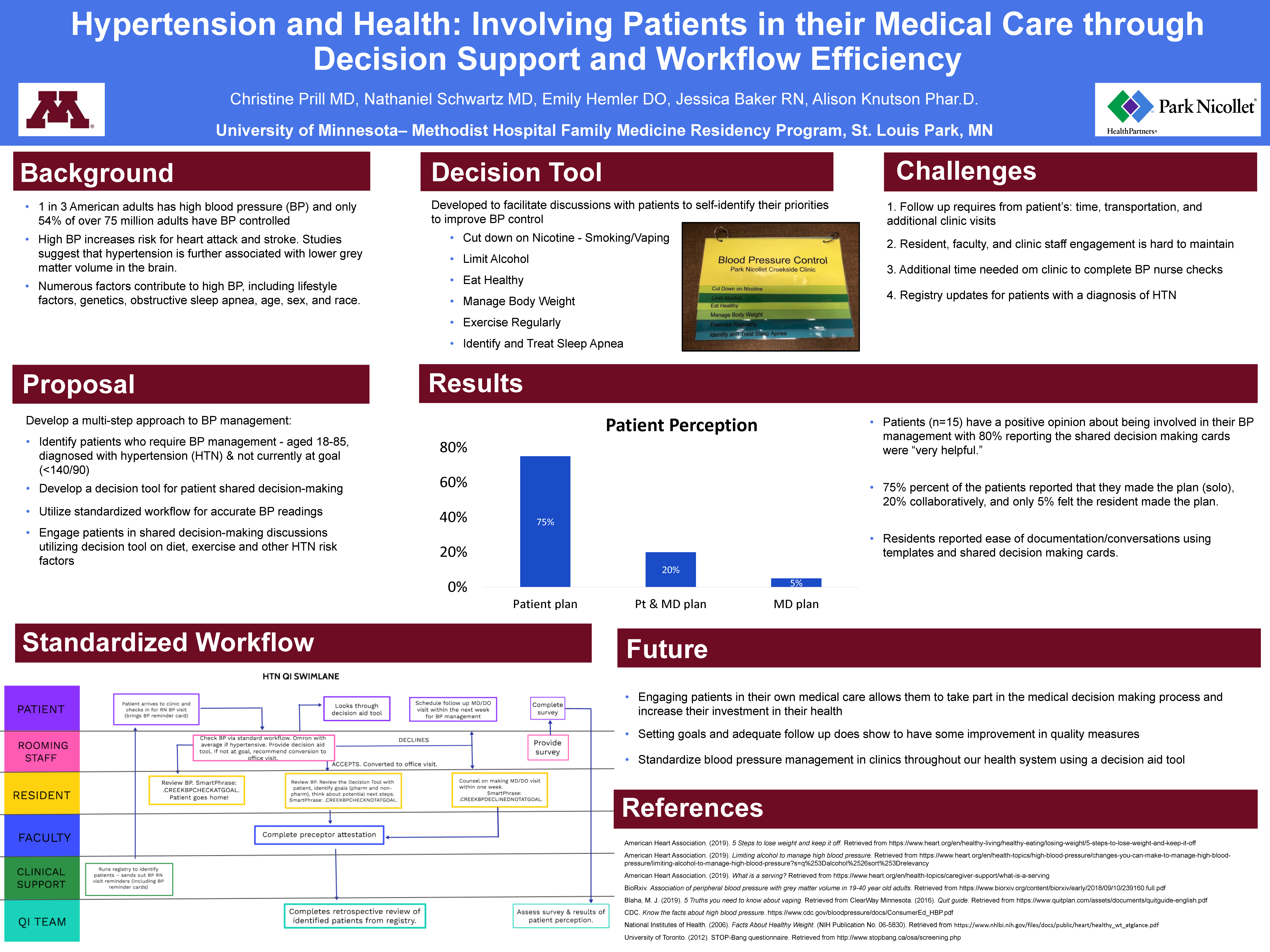|
PS31 - Hypertension and Health: Involving Patients in their Medical Care through Decision Support and Workflow Efficiency
Poster Presenter:
Christine Prill, University of Minnesota - Methodist Family Medicine Residency Program
St. Louis Park, MN
Additional Poster Presenters:
Nathaniel Schwartz, MD. Co-Investigator. University of Minnesota - Methodist Family Medicine Residency Program.
Emily Hemler, DO. Co-Investigator. University of Minnesota - Methodist Family Medicine Residency Program.

Objectives:
One in three adults (75 million) has HTN with only 54% controlling their BP leading to increased cardiac and stroke risks as well as lower grey matter volume in the brain. Factors contributing to high BP include modifiable (lifestyle and obstructive sleep apnea) and non-modifiable factors (age, sex, genetics, and race). The family medicine residency clinic has not been meeting HTN registry goals. This resident project developed a multistep approach to BP management by standardizing clinic workflow, ensuring more accurate BP readings, and engaging patients in shared decision-making (SDM). Decision-making cards were developed to aid patient and residents in discussing healthy eating, exercise, and minimizing risk factors. Aims: to improve BP control and increase patient involvement in self-care.
Methods:
Eligible patients between the ages of 18-85 with a hypertension diagnosis and BP not at goal (<140/90) received a letter requesting a clinic BP check (EMR registry). The letter included suggestions on how to obtain accurate BP readings (e.g. avoid smoking, coffee, and exercise 30 minutes prior to coming in). In clinic visits, began with a nurse BP check, where patients were handed the decision aid card set. If the patient’s BP is at goal, no further engagement was needed. If BP was not at goal, patients were asked to allow the current encounter be converted to a resident visit including BP medication adjustments and shared decision-making. If the patient declines the resident visit, a recommendation is made that they return within the next week for BP follow-up.
Resident visit discussions focused on medication adjustment as well as 1-2 patient chosen SDM cards. The SDM cards included ideas for small, incremental changes that patients could attempt and provide resource ideas as well as encouraging facts (i.e. healthy weight loss is 1-2 pounds per week), created by the clinical team. These were made of brightly colored cardstock laminated as a low cost, low tech conversation starter. Resident visits were documented in the EMR utilizing standardized templates for: BP at goal, not at goal with office visit, and not at goal without office visit. Patients were handed post-visit surveys gauging their opinion of the decision aid and the SDM process.
Results:
Early results from this pilot, show patients (n=15) have a positive opinion about being involved in their BP management with 80% reporting the SDM cards were “very helpful”, 20% “helpful” and all patients reporting they felt their BP self-care plan was “clear”. Seventy-five percent of the patients reported that they made the plan (solo), 20% collaboratively, and only 5% felt the resident made the plan. Residents reported ease of documentation/conversations using templates and SDM cards.
Conclusions:
Additional data analysis is needed to determine changes in hypertension performance scores and patient satisfaction. Reduction of in clinic visits due to Covid-19 have paused wider project implementation. Early results showed improved hypertension registry scores (4th Quarter 2019 +2.0%). Patients’ and residents’ favorable review of the tools ensures that when possible, this project will continue with further monthly review of HTN rates.
|